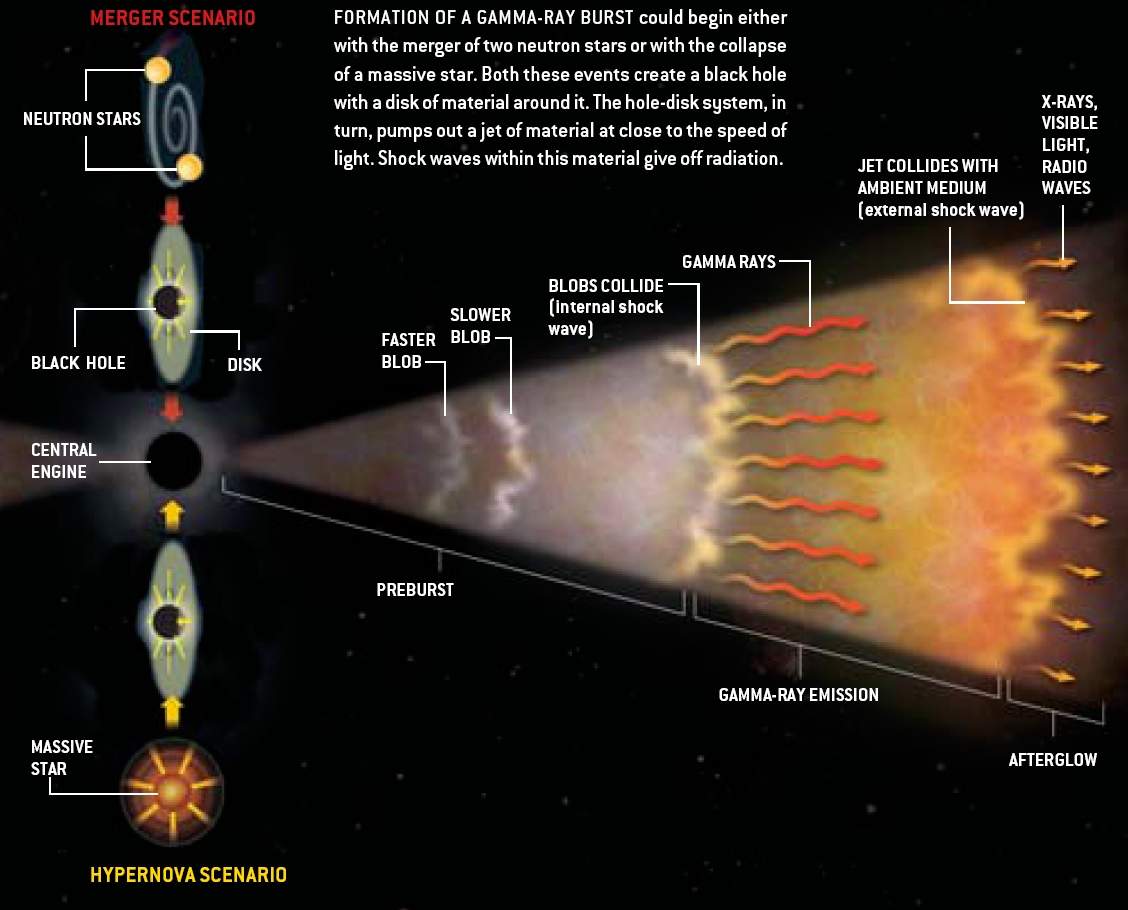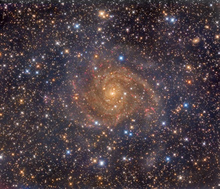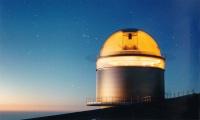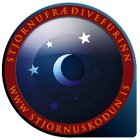Previously the emphasis of the astronomy group was on neutron stars and their surface (e.g. Gudmundsson et al. 1983) and black hole accretion disks (e.g. Björnsson & Svensson 1992). Roughly a decade ago, when Iceland became members of the Nordic Optical Telescope Scientific Association, the focus shifted towards gravitational lenses and the magnification bias (e.g. Rögnvaldsson et al. 2001). Currently our research is mainly focused on gamma-ray bursts (GRBs) and their host galaxies (e.g. Jakobsson et al. 2006).
GRBs are short-lived bursts of gamma-ray photons, the most energetic form of light. Lasting anywhere from a few milliseconds to several minutes, GRBs shine hundreds of times brighter than a typical supernova and about a million trillion times as bright as the Sun, making them briefly the brightest source of cosmic gamma-ray photons in the observable Universe. GRBs are detected roughly once per day from random directions of the sky.

Until recently, GRBs were arguably the biggest mystery in high-energy astronomy. They were discovered serendipitously in the late 1960s by U.S. military satellites which were on the look out for Soviet nuclear testing in violation of the atmospheric nuclear test ban treaty. These satellites carried gamma-ray detectors since a nuclear explosion produces gamma-rays. As recently as the early 1990s, astronomers didn't even know if GRBs originated at the edge of our Solar System, in our Milky Way or far away near the edge of the observable Universe.
In 1997, astronomers finally succeeded in finding the signature of a GRB at optical wavelengths. This was the smoking gun from the GRB itself and is known as the afterglow, a rapidly fading object seen at all wavelengths from radio to X-rays. Ground-based observations of this afterglow revealed its location in the distant Universe. Today, a slew of satellite observations, follow-up ground-based observations, and theoretical work have allowed astronomers to link GRBs to very energetic supernovae (caused by the collapse of a massive star to a black hole) in distant galaxies.
Due to their immense brightness, GRBs can be seen across great distances, even through the dust and debris that can exist within their host galaxies. This implies we can use GRBs to locate galaxies and stars at the very edge of the Universe. Since light can only travel at a finite speed, this also means we are exploring the infant Universe. Hence, GRBs can actually provide us with information when the first stars were born. One aspect of our research is focused on this subject: to systematically search for these far away GRBs and use them to probe the very early Universe and the start of star formation. This is achieved with the aid of one of the largest telescopes in the world, the 8-meter Very Large Telescope (VLT) along with the Nordic Optical Telescope (NOT).
We are also attempting to measure the distance to as many GRBs as possible. In order to do so, we need to extract information from GRB afterglows as early as possible due to their fading behaviour. The Swift satellite, dedicated to GRBs, is built to be fast; in fact its name is not an acronym but a reference to the fact that it can move to GRB positions very quickly. We are using these positions as an input for the VLT and NOT, which in turn measure the GRB distances.
Finally, we want to characterize the GRB host galaxies. Are they similar to galaxies randomly selected in the sky? Do they contain less dust and metals? Are they actively forming stars? Do GRB host galaxies evolve with distance? Currently, we only have a vague idea of how to answer these questions. We are building up a homogeneous and well-understood sample of GRB host galaxies using Swift and a VLT large programme (PI: Jens Hjorth). This will be very valuable, not only to the GRB community, but to astronomers studying star formation and galaxy formation via other methods.
When this research concludes, we hope to have shed light on when the first stars were born, elucidated the distance distribution of GRBs, and characterized the GRB host galaxies.







